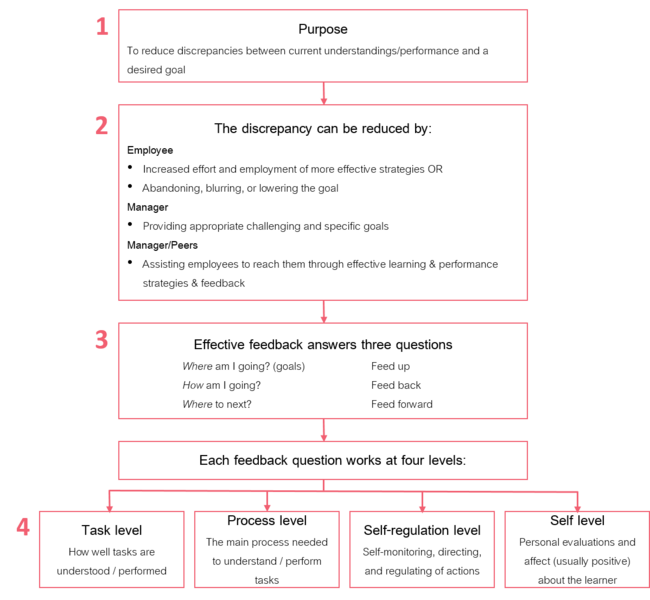ATD Blog
How to Use Peer Feedback to Enhance Performance
Wed Jun 07 2017

We probably all realize that feedback is important, particularly in the workplace. In their 2010 study on feedback, Patricia Harms and Deborah Roebuck argue that in the workplace, feedback as a tool to enhance performance is perceived as “one of the most crucial organizational levers.” But how do we use feedback in an effective way?
The 360-degree feedback survey is a well-known tool in the workplace. However, it doesn’t always do what it’s supposed to: Support learning and enhance performance. There are several reasons why this is the case. First, it’s usually part of the performance management process (to evaluate someone in a summative and quantitative way), which defeats its original purpose and has myriad challenges, such as the type and amount of raters needed to provide accurate and meaningful feedback, choice of response scales, and impact of (cultural) values, norms, and beliefs. Second, 360-degree feedback is usually given only once or twice a year in a scheduled way for a formal performance review.
To give employees the opportunity to enhance their performance, you need to have a process in place that ensures they’ll receive regular, relevant, and actionable feedback meant to improve and not to judge. How else would they know what to keep, what to change, and why to do either?
A feedback process alone is not enough. Feedback needs to be done right to have an impact on someone’s behavior; to help someone learn or improve. But what does right mean? John Hattie and Helen Timperley’s feedback model, which we have adapted for an organizational context in the following figure, gives us evidence-informed directions on how to give effective peer feedback in the workplace, and is therefore a good starting point for exploring.

One thing that clearly stands out while looking at number 1 in the model is that feedback needs to be directed toward a goal. If you intend to give your peer feedback without the person having requested it, you need to consider why that feedback is important and how to give it in a way that’s acceptable to that person. It doesn’t necessarily mean that unaware, unsolicited feedback can’t cause serendipitous learning, just that we don’t know how to do that effectively.
Another critical point is that the feedback needs to relate to critical dimensions of the goal; the dimensions that ensure success. So, if your peer’s goal is to improve communication skills, you might want to hold off giving feedback on the “ugly” colors used in the presentation. Be mindful of what your peer needs and move away from your own preferences and opinions, although these can be tempting to express.
Number 2 shows that there are two main feedback givers in the workplace: managers and peers. There’s a couple of things that are important to realize with regard to these feedback givers. First, although managers might want to help the individual improve, they also have a stake in improving the team, department, organization, and so forth. Sometimes what’s good or needed for the team is not what is optimal for each person! Also, peers in an organization are, to a certain extent, in a competitive working environment, and helping someone else could mean that person getting a raise or promotion above you. However, peers can definitely play a role in one another’s learning and performance enhancement, such as by ensuring that their feedback is effective.
The three questions (number 3 in the model) don’t work in isolation of one another. In the end, effective feedback is about closing the gap between where your peer is and where the person wants to go. So, again, if your peer’s goal is to be more convincing when conveying a message, you as the feedback giver need to be aware of that goal, your feedback needs to focus on how your peer was doing in a certain context or within a certain situation (such as a presentation on project outcomes or a sales pitch), and you need to give an idea on what your peer can do to improve. The two latter points are where the focus of the feedback comes in (number 4).
At a task level, you could let a peer know that certain information in the message wasn’t correct and why. This type of feedback can be powerful, especially as a pedestal on which processing and self-regulation feedback can be built. It’s important for your peer to understand why something is incorrect and how to get it right.
Another very effective type of feedback is epistemic and suggestive feedback. This type of feedback includes suggestions and questions. At a task level, you could ask your peer “Why did you do it that way?” or “What other information could you have given the audience?”
If you want to give a peer feedback on the process, corrective feedback could be something like, “You need to focus on the big picture first before you dive into detail, otherwise people won’t understand the overall message.” Epistemic feedback could be, “Why do you think so and so in the audience didn’t understand your message?”
When you want to zoom in on the self-regulation level, which is more about the ability to continue to work toward the goal, you can help your peer self-evaluate, such as by emphasizing that the person is already very good at explaining the details, but also needs to frame the bigger picture for the audience. This type of feedback is quite complex because there are many factors at play. For example, to effectively use this type of feedback, the person needs to be able to self-assess, be willing to invest effort into seeking and dealing with feedback, and have a level of proficiency to seek help.
In other words, the feedback receiver needs self-regulated learning skills to self-assess and know what to do to get better. These skills are about the ability to monitor and steer your own learning processes. However, a 2013 study in the Annual Review of Psychology found that “research on learning, memory, and metacognitive processes has provided evidence that people often have a faulty mental model of how they learn and remember, making them prone to both misassessing and mismanaging their own learning.”
There’s a lot of research on how to improve self-regulated learning skills, much that goes beyond the goal of this blog post. To put it extremely simply, you need a certain level of domain knowledge to be able to self-regulate in the first place. Then, if you have enough domain knowledge, epistemic and suggestive feedback (asking the right questions) and reflection can play a role in improving these skills.
Lastly, feedback can also be related to “self,” as in, “You have a very pleasant voice” or, “You came across quite nervous,” but this type of feedback is too often unrelated to performance and has a risk to only express personal preference.
Giving effective feedback is a skill and requires both knowledge and practice. It would be great if teams in the workplace could integrate feedback in their day-to-day work flow, using a model as we’re illustrated here. It would give them the opportunity to make more conscious choices on what feedback they want to give their peers and why. Even better would be opportunities for reflection, or conversations between the feedback giver and the feedback receiver to untangle their feedback process.
Editor’s Note: This blog post has been adapted from the authors’ 2016 article, “Peer Feedback in the Workplace: How to Do It Effectively to Enhance Performance,” posted on 3-Star Learning Experiences.
